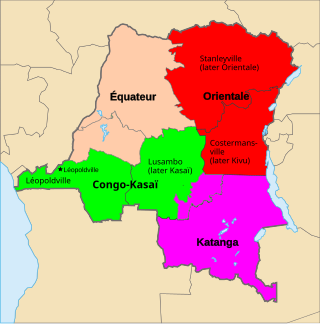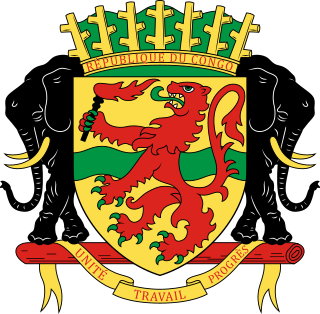
Katanga was one of the four large provinces created in the Belgian Congo in 1914. It was one of the eleven provinces of the Democratic Republic of the Congo between 1966 and 2015, when it was split into the Tanganyika, Haut-Lomami, Lualaba, and Haut-Katanga provinces. Between 1971 and 1997, its official name was Shaba Province.

Kinshasa, formerly named Léopoldville until June 30, 1966, is the capital and largest city of the Democratic Republic of the Congo. Once a site of fishing and trading villages along the Congo River, Kinshasa is now one of the world's fastest-growing megacities. Kinshasa's 2024 population was estimated at 17,032,322. It is the most densely populated city in the DRC and the most populous city in Africa, the fourth-most-populated capital in the world, Africa's third-largest metropolitan area and the leading economic, political, and cultural center of the DRC. Kinshasa houses several industries, including manufacturing, telecommunications, banking, and entertainment. The city also hosts some of DRC's significant institutional buildings, such as the Palais du Peuple, Palais de la Nation, Court of Cassation, Constitutional Court, Cité de l'Union Africaine, Palais de Marbre, Stade des Martyrs, Immeuble du Gouvernement, Kinshasa Financial Center, and multiple federal departments and agencies.

Brazzaville is the capital and largest city of the Republic of the Congo. Administratively, it is a department and a commune. Constituting the financial and administrative centre of the country, it is located on the north side of the Congo River, opposite Kinshasa, the capital city of the Democratic Republic of the Congo.

The Democratic Republic of the Congo (DRC), also known as the DR Congo, Congo-Kinshasa, Congo-Zaire, or simply either Congo or the Congo, is a country in Central Africa. By land area, the DRC is the second-largest country in Africa and the 11th-largest in the world. With a population of around 105 million, the Democratic Republic of the Congo is the most populous Francophone country in the world. The national capital and largest city is Kinshasa, which is also the economic center. The country is bordered by the Republic of the Congo, Central African Republic, South Sudan, Uganda, Rwanda, Burundi, Tanzania, Zambia, Angola, the Cabinda exclave of Angola, and the South Atlantic Ocean.

The president of the Democratic Republic of the Congo is the head of state of the Democratic Republic of the Congo and commander-in-chief of the armed forces.

The DR Congo national football team, recognised by FIFA as Congo DR, represents the Democratic Republic of the Congo in men's international football and it is controlled by the Congolese Association Football Federation. They are nicknamed Les Léopards, meaning The Leopards. The team is a member of FIFA and the Confederation of African Football (CAF).

UTC+01:00 is an identifier for a time offset from UTC of +01:00. In ISO 8601, the associated time would be written as 2019-02-07T23:28:34+01:00. This time is used in:

Article 2 of the Constitution of the Democratic Republic of the Congo divides the country into the capital city of Kinshasa and 25 named provinces. It also gives the capital the status of a province. Therefore, in many contexts Kinshasa is regarded as the 26th province.

The People's Republic of the Congo was a Marxist–Leninist socialist state that existed in the Republic of the Congo from 1969 to 1992.
Richard Edward "Rich" Lambourne is an American indoor volleyball player. He joined the U.S. men's national team in 2000 as the designated libero. He has recently played for Delecta Bydgoszcz. Lambourne made his Olympic debut at the 2008 Olympics, helping Team USA to a gold medal.

The Republic of the Congo was a sovereign state in Central Africa, created with the independence of the Belgian Congo in 1960. From 1960 to 1966, the country was also known as Congo-Léopoldville to distinguish it from its northwestern neighbor, which is also called the Republic of the Congo, alternatively known as "Congo-Brazzaville". In 1964, the state's official name was changed to the Democratic Republic of the Congo, but the two countries continued to be distinguished by their capitals; with the renaming of Léopoldville as Kinshasa in 1966, it became also known as Congo-Kinshasa. After Joseph Désiré Mobutu, commander-in-chief of the national army, seized control of the government in 1965, the Democratic Republic of the Congo became the Republic of Zaire in 1971. It would again become the Democratic Republic of the Congo in 1997. The period between 1960 and 1964 is referred to as the First Congolese Republic.

The Republic of the Congo, also known as Congo-Brazzaville, West Congo, Congo Republic, ROC, ROTC, or simply either Congo or the Congo, is a country located on the western coast of Central Africa to the west of the Congo River. It is bordered to the west by Gabon, to the northwest by Cameroon, to the northeast by the Central African Republic, to the southeast by the Democratic Republic of the Congo, to the south by the Angolan exclave of Cabinda, and to the southwest by the Atlantic Ocean.

Visitors to the Republic of the Congo must obtain a visa from one of the Republic of the Congo diplomatic missions unless they come from one of the visa exempt countries or countries that can obtain a visa on arrival.

Leuconitocris is a genus of longhorn beetles of the subfamily Lamiinae, containing the following species:
Leuconitocris microphthalma is a species of beetle in the family Cerambycidae. It was described by Stephan von Breuning in 1950, originally under the genus Nitocris. It is known from Sierra Leone and the Democratic Republic of the Congo.
Leuconitocris argenteovittata is a species of beetle in the family Cerambycidae. It was described by Per Olof Christopher Aurivillius in 1914.
Leuconitocris buettneri is a species of beetle in the family Cerambycidae. It was described by Hermann Julius Kolbe in 1893.
Leuconitocris juvenca is a species of beetle in the family Cerambycidae. It was described by Brancsik in 1914. It is known from Tanzania, South Africa, the Democratic Republic of the Congo, Mozambique, Zimbabwe, and Zambia.
Leuconitocris nigricornis is a species of beetle in the family Cerambycidae. It was described by Olivier in 1795, originally under the genus Necydalis. It is known from Tanzania, South Africa, the Central African Republic, Mozambique, Uganda, Malawi, and Zambia.













